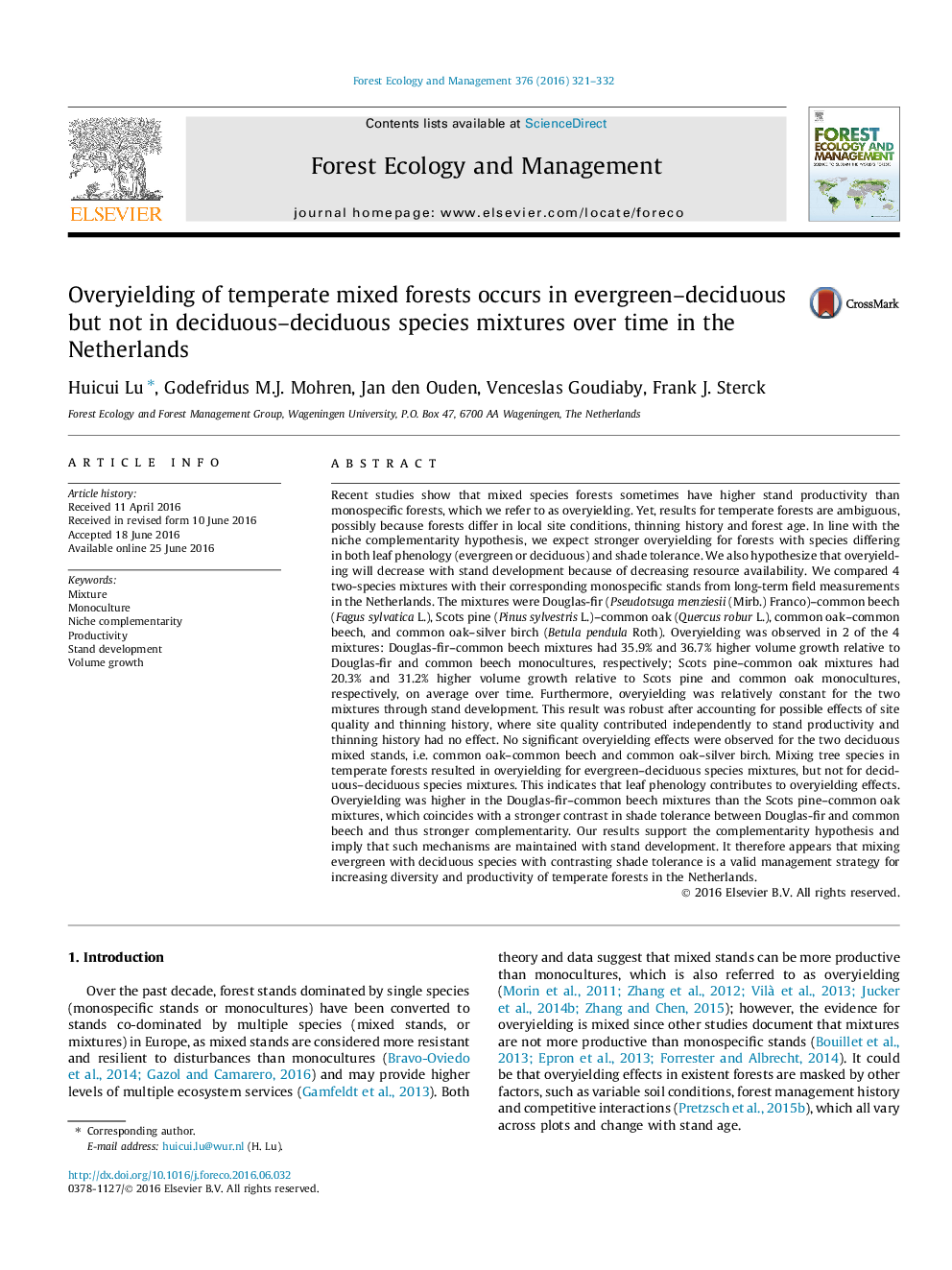| کد مقاله | کد نشریه | سال انتشار | مقاله انگلیسی | نسخه تمام متن |
|---|---|---|---|---|
| 6542148 | 159145 | 2016 | 12 صفحه PDF | دانلود رایگان |
عنوان انگلیسی مقاله ISI
Overyielding of temperate mixed forests occurs in evergreen-deciduous but not in deciduous-deciduous species mixtures over time in the Netherlands
ترجمه فارسی عنوان
استفاده از جنگل های مخلوط معتدل در سالهای اخیر در هلند و در میان گیاهان با برگ های گیاهخوار و لیزا،
دانلود مقاله + سفارش ترجمه
دانلود مقاله ISI انگلیسی
رایگان برای ایرانیان
کلمات کلیدی
مخلوط، تک کشتار، تکمیلی نیک، بهره وری، توسعه پایدار، رشد حجم،
موضوعات مرتبط
علوم زیستی و بیوفناوری
علوم کشاورزی و بیولوژیک
بوم شناسی، تکامل، رفتار و سامانه شناسی
چکیده انگلیسی
Recent studies show that mixed species forests sometimes have higher stand productivity than monospecific forests, which we refer to as overyielding. Yet, results for temperate forests are ambiguous, possibly because forests differ in local site conditions, thinning history and forest age. In line with the niche complementarity hypothesis, we expect stronger overyielding for forests with species differing in both leaf phenology (evergreen or deciduous) and shade tolerance. We also hypothesize that overyielding will decrease with stand development because of decreasing resource availability. We compared 4 two-species mixtures with their corresponding monospecific stands from long-term field measurements in the Netherlands. The mixtures were Douglas-fir (Pseudotsuga menziesii (Mirb.) Franco)-common beech (Fagus sylvatica L.), Scots pine (Pinus sylvestris L.)-common oak (Quercus robur L.), common oak-common beech, and common oak-silver birch (Betula pendula Roth). Overyielding was observed in 2 of the 4 mixtures: Douglas-fir-common beech mixtures had 35.9% and 36.7% higher volume growth relative to Douglas-fir and common beech monocultures, respectively; Scots pine-common oak mixtures had 20.3% and 31.2% higher volume growth relative to Scots pine and common oak monocultures, respectively, on average over time. Furthermore, overyielding was relatively constant for the two mixtures through stand development. This result was robust after accounting for possible effects of site quality and thinning history, where site quality contributed independently to stand productivity and thinning history had no effect. No significant overyielding effects were observed for the two deciduous mixed stands, i.e. common oak-common beech and common oak-silver birch. Mixing tree species in temperate forests resulted in overyielding for evergreen-deciduous species mixtures, but not for deciduous-deciduous species mixtures. This indicates that leaf phenology contributes to overyielding effects. Overyielding was higher in the Douglas-fir-common beech mixtures than the Scots pine-common oak mixtures, which coincides with a stronger contrast in shade tolerance between Douglas-fir and common beech and thus stronger complementarity. Our results support the complementarity hypothesis and imply that such mechanisms are maintained with stand development. It therefore appears that mixing evergreen with deciduous species with contrasting shade tolerance is a valid management strategy for increasing diversity and productivity of temperate forests in the Netherlands.
ناشر
Database: Elsevier - ScienceDirect (ساینس دایرکت)
Journal: Forest Ecology and Management - Volume 376, 15 September 2016, Pages 321-332
Journal: Forest Ecology and Management - Volume 376, 15 September 2016, Pages 321-332
نویسندگان
Huicui Lu, Godefridus M.J. Mohren, Jan den Ouden, Venceslas Goudiaby, Frank J. Sterck,
